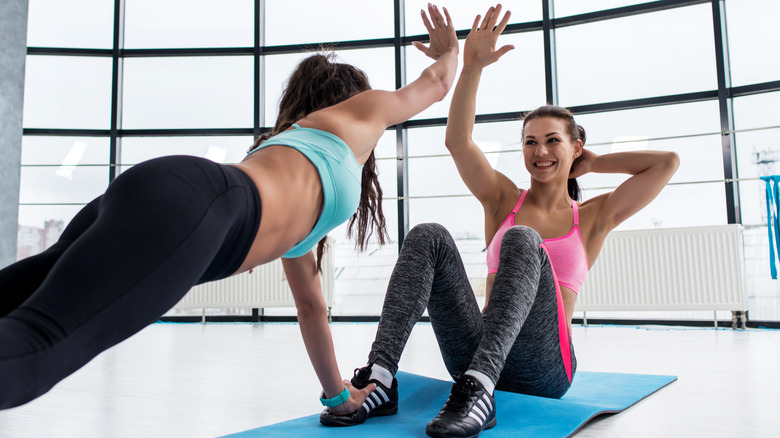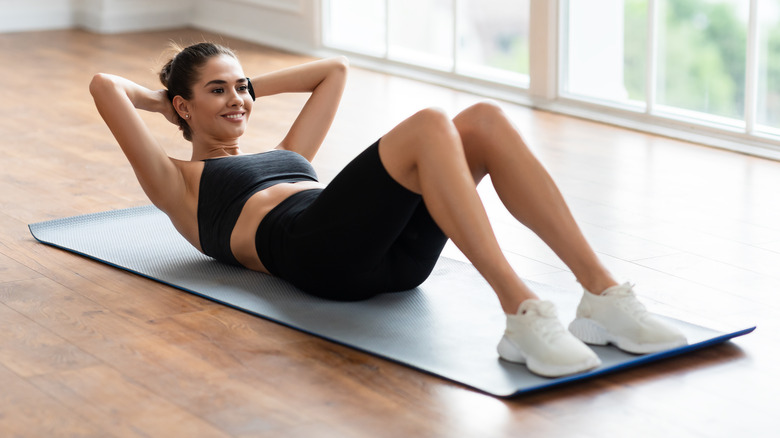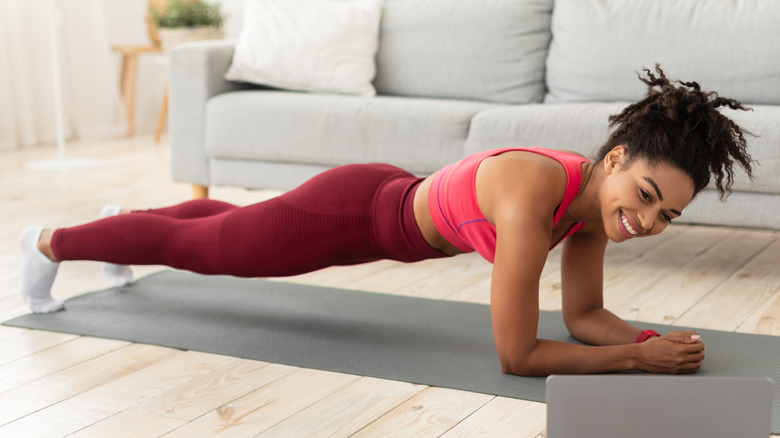How Do Crunches And Planks Stack Up Against Each Other?
We may receive a commission on purchases made from links.
When it comes to strength training, there's more than one way to work a muscle group. Want stronger legs? WebMD recommends squats or lunges. Trying to build a bigger booty? Livestrong says weighted glute bridges or Bulgarian split squats will do the trick. But these are just a few of the many options that can work these muscles, and the core is no different. There are many ways to strengthen it, but two of the most common methods are crunches and the plank.
What's nice about both of these exercises is that you can do them anywhere and you don't need any equipment. Plus, they can both help strengthen your core and give you visibly toned abs — when combined with a healthy diet. Having a strong core can help you perform better in a variety of other exercises while giving you better balance, posture, and stability, according to Mayo Clinic. But what are the differences between these two core moves? Is one better or safer than the other, and do they work the exact same muscles?
Crunches work the abs and obliques, but with risks
A crunch involves lying on your back with your knees bent and feet about hip-width apart. The movement is similar to a sit-up, except you don't need to lift your upper body up as high. Livestrong provides a basic video demonstration of the crunch on YouTube, but there are several variations. Verywell Fit lists five versions, which include the bicycle crunch, reverse crunch, and crossover crunch.
Crunches work the rectus abdominis muscles, which are located on the front of the abdomen and are better known as the six-pack muscles. When people talk about killer abs, they're talking about these muscles. However, it's important to note that you have to reduce belly fat if you want that six-pack to show, as Healthline explains. Doing crunches can help tone the front ab muscles as well as the oblique muscles, which are located on both sides of the torso.
But despite these benefits, many personal trainers discourage crunches partially because they're too easy to do incorrectly, which can lead to stress on the lower back, according to Business Insider.
Planks work the abs, obliques, and more
Unlike crunches, planks involve resting on the palms (in a push-up position) instead of your back, but you can also rest on your forearms. In fact, there are more than a dozen plank variations, 14 of which are listed on Healthline, including one for a straight-arm plank, forearm plank, and straight-arm plank with leg lifts.
Planks strengthen all the same muscles as crunches (front ab muscles and obliques), plus a few more, explains Nike. These include the transversus abdominis muscles, located in the abdomen via OrthoCarolina. The back muscles, hip flexors, hamstrings, and glutes are also activated when performing a plank, according to Nike.
When compared to crunches, many personal trainers recommend planks because they force you to stabilize your core. A Les Mills study compared the two moves to determine which one resulted in the most muscle activation. The winner? Planks. This move was found to "provide optimal results when it comes to aiding sports performance, rehab, and general fitness."
Regardless of which exercise you choose to do, it's important to ensure you use the proper form to avoid injury and to ensure optimum muscle activation. And remember, if you want to be able to see those toned abs, you need to make sure you're eating a healthy diet, because as they say — abs are made in the kitchen.


